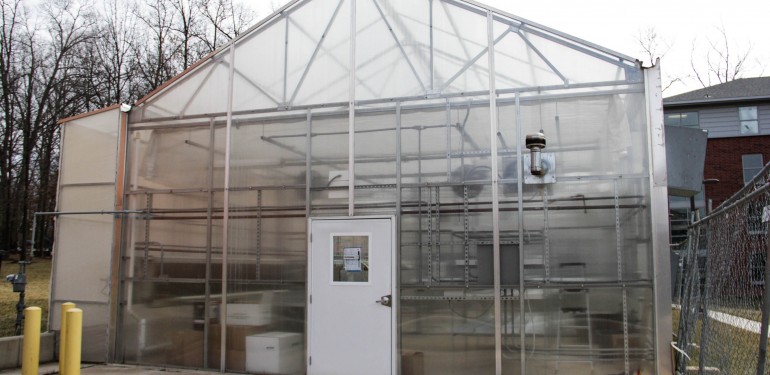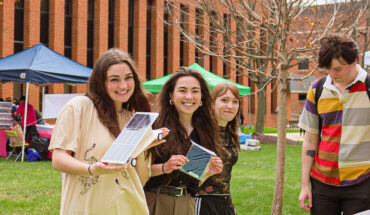This story was originally published in the Feb. 9 issue of Fourth Estate.
The President’s Park Greenhouse will start harvesting food for Ike’s dining hall this spring.
“We have an arrangement with Sodexo where they have committed to $20,000 a year to support this project in exchange for us giving them all of our produce that we grow,” Director of Outreach for the Office of Sustainability Danielle Wyman said.
The arrangement also has an understanding that the first year’s use of the greenhouse will not produce the maximum capacity of food. The maximum is expected to be thousands of pounds of produce per year. The greenhouse will grow leafy greens such as lettuce, basil, oregano and cilantro and also microgreens.
“We’ll be growing microgreens, which are only a couple week old plants and the nice thing about them is that they’re really nutrient dense, and they’re packed full of flavor,” Wyman said.
The microgreens available will include corn sprouts; sweet pea sprouts; arugula sprouts; mizuna, which is a type of cabbage; and amaranth, which is similar to quinoa. According to Wyman, these tend to be served at high-end restaurants as garnishes, and everything except the root of the microgreen plant is edible.
Although everything will be grown locally and nothing will be sprayed with pesticides, the food won’t be certified organic.
“The fertilizers are not certified organic. It’s mined from different parts of the world and then shipped overseas,” Greenhouse Coordinator Donielle Ward said. “But we do have a local business that we’re in communication with that they’re experimenting with creating an organic fertilizer made for hydroponics.”
The produce will be grown with hydroponics technology. This means that no soil will be used, all the nutrients are mixed into the water and less water is used compared to soil-planting. The Office of Sustainability is new to hydroponics technology, but according to Wyman, they have researched and been trained on it to prepare for operating the greenhouse.
“So it’s very clean,” Ward said. “When we sell the produce there’s no dirt from the ground on it. You still have to wash it before you serve it, but it’s not nearly as laborious a process.”
The hydroponics growing channels are slightly tilted so that a stream of about 1/8 inch of water trickles down to all of the plants’ roots. This water is then circulated through the plumbing and reused again. The plumbing equipment is still being installed.
Due to being dormant for one year and the ongoing construction nearby at Taylor Hall, the 2,000 square foot greenhouse had some cleaning and repair recently done. It was used for science classes, but became available for the Office of Sustainability when the Exploratory Hall rooftop greenhouse opened in. But there are talks about adding more greenhouses to Mason’s campuses. Ward thinks that the Prince William campus would be a good choice because of the amount of land available.
“Our Sodexo representation, Michel Wetli, every time we meet with him he starts dreaming up all these big stories like how food at Mason is going to evolve into being very fresh, very local, organic; that’s what we’re heading towards,” Ward said. “He wants more greenhouses, more systems, more fresh food, he’s all about it.”
Welti was unavailable for comment on this new partnership. However, according to its website, Sodexo started a global sustainability project in 2009 called “The Better Tomorrow Plan.” Its four priorities are: “as an employer, actively promote nutrition, health and wellness, commit to local communities and protect the environment.”
“I think it’s [the greenhouse] a great initative that will utilize unused university land and save precious finite resources, particularly petrol,” senior and government major Justin Yu said. “However, greater insight must be taken into how such foodstuffs are produced, [type of] fertilizer pesticides and [the] labour hired.”
Ward is the only Mason employee solely assigned to the greenhouse project. Ward and Wyman hope that student and faculty are interested in volunteering. Mason students don’t need to be enrolled in a related science or environmental course to participate.
“The main purpose is educational. It’s a tool for Mason students and also the community as a learning opportunity to learn how to grow food in a space-saving environment, indoors,” Ward said.
The greenhouse will also produce compost for the campus gardens. There are three boxes with a total of around 4,000 of red wriggler worms.
“There’s going to be quite a bit of waste from the roots [of microgreens]…and we can put all that waste instead of putting it in the trash, we can feed it to the worms and that turns into more fertilizer to help the garden,” Ward said.
Ward and Wyman plan for the first harvest to be around early March. There will also be a ribbon-cutting event for the renovated greenhouse sometime around Earth Week in April.
Photo credit: Erika Eisenacher




